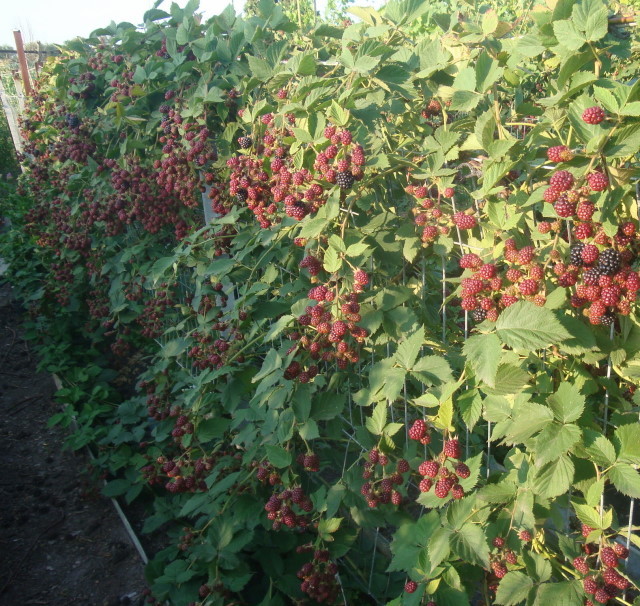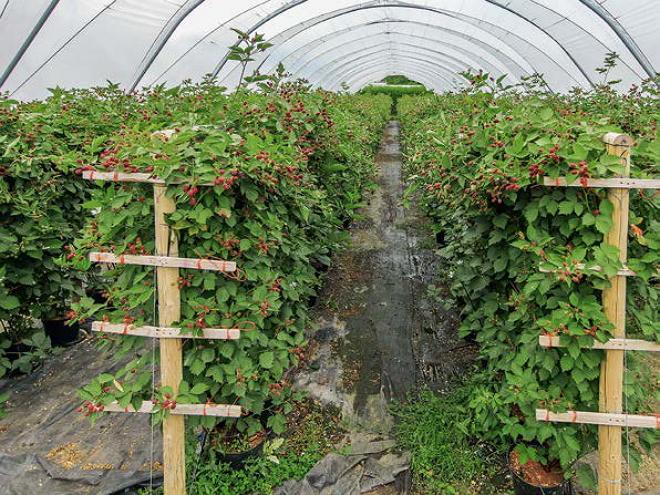Do-it-yourself blackberry trellis
Content
Garden trellis designs
Blackberry bushes can be upright (kumanika) shoots or creeping (dew) shoots. Kumanik branches are powerful and almost rigid, they grow in many varieties up to 3 m, bend arcuately, especially under the weight of the fruit. In mildews, flexible shoots spreading along the ground grow even more - sometimes, up to 6 m.There are also semi-creeping varieties, the shoots of which until a certain moment (60 cm, 100 cm) grow straight up, and then bend downward, as if tired of reaching for the sky.
Far from all varieties of kumanik, branches can withstand the weight of the fruit, they need support, and there is simply no point in growing dewweeds without it - the branches will intertwine on the ground in a large picturesque ball, the harvest is more likely to go to dexterous birds than to people.
Trellis for blackberries are sure to suit for industrial cultivation in large volumes. Even if there is only one blackberry bush in the garden, he certainly needs to make a support that will not only facilitate the work of the owner, but also turn the bush itself into a garden decoration, emphasizing its decorative effect.
There are several of the most convenient and therefore common designs. A do-it-yourself trellis for blackberries may well be made of metal, wood or plastic and strong wire. Usually this is a lattice structure consisting of firmly installed (fixed in the ground) racks, on which a different amount of wire is stretched horizontally. The branches of the bushes are directed to different levels or different sides, fixed or even wound on a wire. There are simple straight racks with wire, and there are racks of various shapes, together with a bush, they form beautiful forms - fans, arches, a house, an intricate figure. But they all perform a completely utilitarian function - they support long heavy branches, arrange them for the best perception of the sun's rays, do not allow you to create an extra shadow for each other, create convenience for walking behind the plant and harvesting.
The T-shaped structure assumes two vertical posts, dug in at the edges of the row, on which transverse strips are stuffed, and rows of wire are stretched over them. The racks should be about 2 m high, well fixed in the ground, the transverse strips with their length determine the width of the row (this can be 50 or 60 cm), they pull a wire with a cross section of at least 5 mm at a height of 50, 100, 150 cm. economy, then the rows will be long, the racks should be placed at a distance of 6 - 8 m, 2 or even 2.5 meters should be left between the rows. And the plants themselves are usually not planted densely - straight-growing - after 70 - 80 cm, and creeping - after 1.3 - 1.5 m.It happens that three rows of wire are stretched between the racks only on one side (without transverse strips), then otherwise shoots are distributed, but it is not recommended to tie them in bundles.Such trellises are directed from north to south so that the plantings receive maximum sunlight.
A V-shaped trellis is made by stuffing transverse strips at the top with a length of 70 - 80 cm. The yield of the bushes on such a structure is higher, because the penetration of air and sunlight is much better, the bush seems to open towards the sun. Using such trellises, they organize a blackberry hedge.
There are even movable swivel trellises, the manufacture of which provides for an inclination to both sides of the row for targeted illumination of the sun in turn on different sides of the bush. With the onset of flowering, the frame is turned so that it becomes almost parallel to the ground, more flowers and berries are formed on this side. As it matures, it rises to an upright position. On this basis, a system for mechanized harvesting has been developed in the United States: the moving part is first turned by the flowers upward towards the sun, and when the berries ripen, it turns to the moving harvester, which removes the berries.
When building a trellis for a blackberry in your garden yourself, you can choose from the existing options or come up with your own design option, which will be the best choice for your garden.
Video "The benefits of trellis for blackberries"
In this video, an experienced gardener will talk about the benefits of a trellis for this magnificent berry.
Schemes for tying stems to a trellis
Since the shoots of the second year bear fruit near the blackberry bush, in the spring it is necessary to fix the branches on which the fruits will be on the trellis, and the young replacement shoots, which will only grow, are guided and fixed gradually during the summer. It is very convenient to place them separately from each other.
If the bush is formed as a fan, then the existing shoots are fixed on one side, and the young growing ones on the other. It so happens that you can harvest only from one side of the bush, and in the fall all shoots on this side are completely removed, they will not get confused with new young shoots, which are simply shortened in autumn and sheltered from frost. Some gardeners fix the fruiting shoots right in the middle, spreading them so that they do not shade each other, and the young ones direct them to the right and left of them - so nothing will get confused either. This is usually the case with kumaniks. But the dewdrop has too long and flexible branches to simply direct, they are braided.
Left for fruiting, already in the spring, the long branches of creeping varieties are raised to the very top, each of them is twisted several times around the upper wire, then lowered to the middle one. They grow further, they are entwined several times around the middle wire and raised to the top - this continues all summer.
And young shoots, which are just beginning to grow in the current year, are wrapped around the lower wire. The main thing is to do it not too densely, so that all the buds of young shoots have enough sun and freedom for further development.
Other summer residents prefer to bring young shoots to the upper level in the middle, and fix the fruiting ones at the two lower levels, directing them in different directions - it is easier to harvest.
You can choose different options for tying shoots to the trellis, the main thing is that in the fall they can be easily removed, so that young shoots do not get confused with fruiting ones, so that in summer all the branches have enough sun and air.
Video "Formation of blackberries on a trellis"
In this video you will see how blackberries develop on a trellis.



